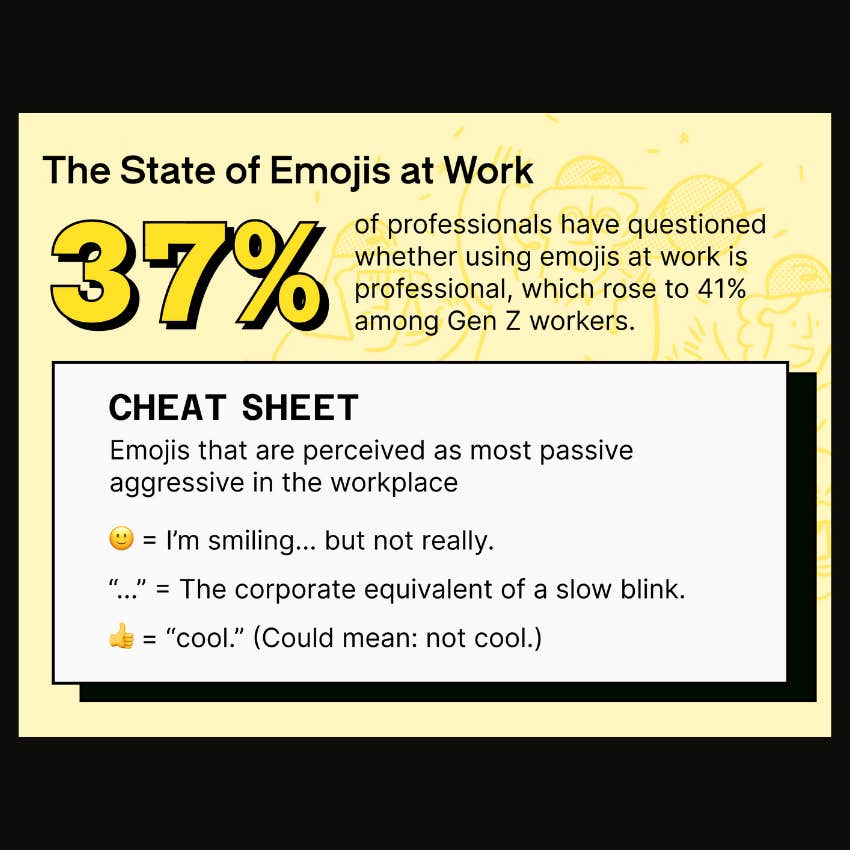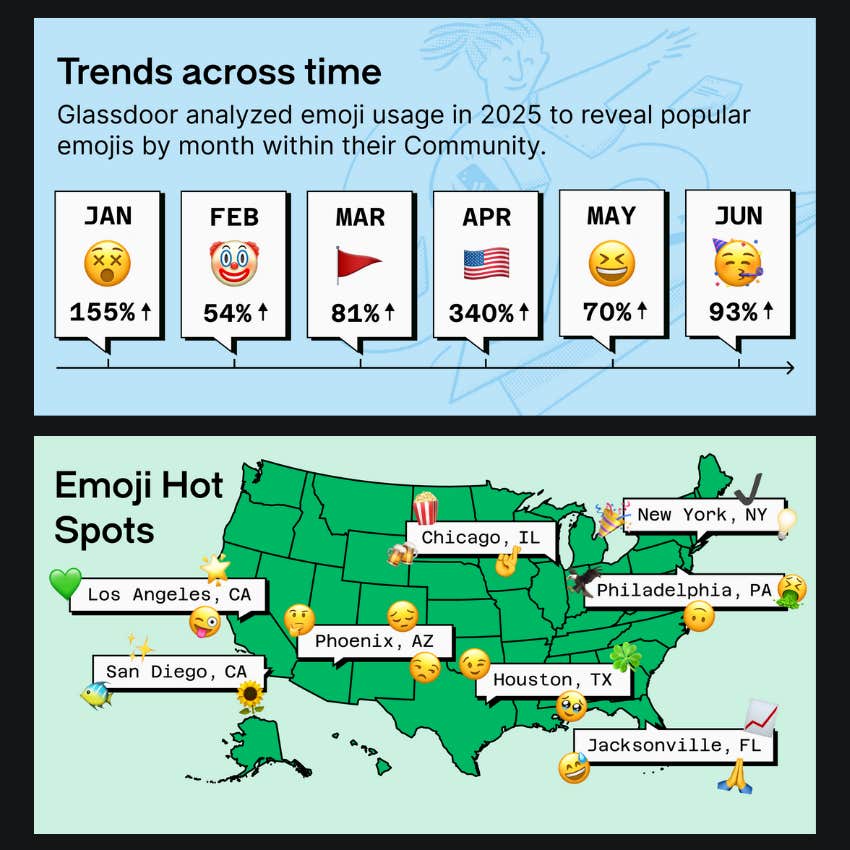If You Use Any Of These Emojis At Work, Survey Says Your Co-Workers Probably Think You’re Passive Aggressive
Emojis are making the already fraught world of office communication even more dicey!
 DJ Creative Studio | Shutterstock
DJ Creative Studio | Shutterstock Office communication is already a delicate business. You just never know if a joke won't land or a story from your off-hours that feels innocuous to you is going to seem bonkers to the lady from accounts payable. Now add emojis to the mix. Things start to get truly wild.
The often hard-to-interpret nature of online communication makes this even more fraught, and a new survey reveals that one of our favorite parts of digital discourse, emojis, is causing some awkwardness on the ol' office chat channel.
A survey found that there are 3 emojis that make your co-workers think you're passive-aggressive.
As you've no doubt noticed, online communication is often hard to decipher given the way it lacks tone and context. If you've ever gone full stomach-flipping nauseous panic because someone simply said, "Can we talk for a second?" you've experienced this. Talk about what, last night's episode of "The White Lotus" or how I am being fired from this job?!
But when it comes to emojis, it seems like the subtleties might be even more… well, subtle. The folks at Glassdoor, the job search and review platform, recently did a deep dive into emoji usage at the office, asking 1,000 workers if they've ever felt nervous that their emoji usage at work might be misconstrued.
 ssi77 | Shutterstock
ssi77 | Shutterstock
Their findings are somewhat in alignment with generational divides over emojis and other texting conventions. Many Gen Zers tend to find emojis "cringe" in general, and those who do use them often use different ones than us olds do. Using the crying-laughing emojis instead of a skull to say "LOL" marks you as a grandpa, for instance. And lots of Gen Zers only use emojis ironically, as a way to mock us older people for being old. (BRB while I burst into elderly tears😭.)
Anyway, these generational divides seem to be carried over to the workplace. Glassdoor's survey revealed there are three emojis in particular that cause consternation, and an informal poll of the folks here at YourTango reveals it is definitely age-related.
The half-smile, thumbs up, and ellipsis emojis were voted most passive-aggressive.
 Glassdoor | Canva Pro
Glassdoor | Canva Pro
On its face, the half-smile emoji — this one 🙂 — just looks like…well, a half-smile, innocuous as can be. But Glassdoor's respondents ranked it as the most passive-aggressive, or at least the most difficult to decipher emoji at work.
They said it comes off as "I'm smiling… but not really," kind of like how we all sort of just sense that "regards" at the end of an email actually means "I hope you never know peace and I wish the same on your entire bloodline." It's got a sort of "I'm smiling so HR won't know I'm about to ruin your life" vibe to it, if you think about it.
Next was another generational divide and one that has been exhaustively debated online: The ellipsis emoji (or just ellipses themselves). For older folks, it's a way to make a message seem more casual or indicate that a thought isn't necessarily entirely fleshed out. But to a lot of younger folks, it feels downright ominous, and at work, respondents told Glassdoor it's "the office equivalent of a slow blink" of the "you cannot be serious" variety.
And in third place was the thumbs-up emoji, which seems equally innocuous. "Uh oh, I use the thumbs-up all the time," my Gen X editor said when I brought this up. She explained that to her, it's just a way to acknowledge that a piece of information has been received. I use it this way too, as a Xennial.
But some of our Gen Z colleagues said it tends to feel sarcastic, like a "yeah okay whatever," the kind of response that you, say, give to your boyfriend to let him know that you're done arguing, but you definitely don't forgive him and he should shut up immediately. Which makes sense: An ironically cheerful 👍is a pretty perfect response to "babe, I SAID I was sorry."
These weird communication emoji misunderstandings seem to be causing anxiety at work.
Perhaps unsurprisingly, Glassdoor found that all these different understandings of emojis, generational or otherwise, are freaking people out at work quite a bit. Out of their 1,000 respondents, 37% have questioned whether their emoji use at work has come off as intended. For Gen Z, the rate was even higher at 41%.
 Glassdoor | Canva Pro
Glassdoor | Canva Pro
But, much like in our personal lives, they don't seem likely to go anywhere. Glassdoor found that emoji use at work is increasing, and they even found some interesting trends in what emojis have been on the rise in the 2025 workplace.
For example, the hottest workplace emojis in January, February, and March were the dead eyes, clown, and red flag emojis, respectively. And if that isn't reflective of how 2025 has gone so far, well… I just don't know what is. (Sorry for the ellipsis, don't take it personally!)
John Sundholm is a writer, editor, and video personality with 20 years of experience in media and entertainment. He covers culture, mental health, and human interest topics.

